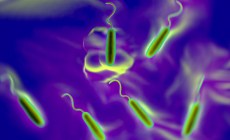Cholera case was first reported last July 26 in Kathmandu.
- Epidemiology and Disease Control Division confirmed 29 cases of cholera have been in the area since first report.
- There are 29 stool samples of 200 has been positive in bacterium Vibrio cholerae.
According to Dr Baburam Marasini, EDCD director, 29 cases of cholera had tested positive, but said no cholera death had been reported. Diarrhea patients who tested positive for cholera were admitted to Shukraraj Tropical and Infectious Disease Hospital, Teku, for treatment. More than 75 per cent of the patients have been discharged after treatment. Most of the patients were from Kalimati, Kuleshwor, Soalteemode, Kalanki and Naikap.
The patients were rushed to the hospital when symptoms had developed like nausea, vomiting, headache and loose motion, among others. Medical and technical team had been deployed in the area by EDCD.
Last Aug.3, the team started investigation,15 water sample collected from as many places and brought to the laboratory for tests. The team found out that contaminated water was the only reason behind the cases of cholera, spread of diseases in the area was because of poor sanitation and personal hygiene. Residents had been advised to boil water for disease prevention.
Cholera is an infection of the small intestine by some strains of the bacterium Vibrio cholerae. Symptoms may range from none, to mild, to severe. The classic symptom is large amounts of watery diarrhea that lasts a few days. Vomiting and muscle cramps may also occur. Diarrhea can be so severe that it leads within hours to severe dehydration and electrolyte imbalance. This may result in sunken eyes, cold skin, decreased skin elasticity, and wrinkling of the hands and feet. The dehydration may result in the skin turning bluish. Symptoms start two hours to five days after exposure.
Cholera is caused by a number of types of Vibrio cholerae, with some types producing more severe disease than others. It is spread mostly by water and food that has been contaminated with human feces containing the bacteria. Insufficiently cooked seafood is a common source. Humans are the only animal affected. Risk factors for the disease include poor sanitation, not enough clean drinking water, and poverty. There are concerns that rising sea levels will increase rates of disease.Cholera can be diagnosed by a stool test. A rapid dipstick test is available but is not as accurate.
Prevention involves improved sanitation and access to clean water. Cholera vaccines that are given by mouth provide reasonable protection for about six months. They have the added benefit of protecting against another type of diarrhea caused by E. coli. The primary treatment is oral rehydration therapy–the replacement of fluids with slightly sweet and salty solutions. Rice-based solutions are preferred. Zinc supplementation is useful in children. In severe cases, intravenous fluids, such as Ringer’s lactate, may be required, and antibiotics may be beneficial. Testing to see what antibiotic the cholera is susceptible to can help guide the choice.
The primary symptoms of cholera are profuse diarrhea and vomiting of clear fluid. These symptoms usually start suddenly, half a day to five days after ingestion of the bacteria. The diarrhea is frequently described as “rice water” in nature and may have a fishy odor. An untreated person with cholera may produce 10 to 20 litres (3 to 5 US gal) of diarrhea a day. Severe cholera, without treatment, kills about half of affected individuals. If the severe diarrhea is not treated, it can result in life-threatening dehydration and electrolyte imbalances. Estimates of the ratio of asymptomatic to symptomatic infections have ranged from 3 to 100. Cholera has been nicknamed the “blue death” because a person’s skin may turn bluish-gray from extreme loss of fluids.
Fever is rare and should raise suspicion for secondary infection. Patients can be lethargic, and might have sunken eyes, dry mouth, cold clammy skin, decreased skin turgor, or wrinkled hands and feet. Kussmaul breathing, a deep and labored breathing pattern, can occur because of acidosis from stool bicarbonate losses and lactic acidosis associated with poor perfusion. Blood pressure drops due to dehydration, peripheral pulse is rapid and thready, and urine output decreases with time. Muscle cramping and weakness, altered consciousness, seizures, or even coma due to electrolyte losses and ion shifts are common, especially in children.IMAGE/Shutterstock

